You wake up, amble up to your espresso machine, eagerly awaiting that first sip of caffeine. As you’re preparing your puck, you notice something’s not right. The puck container light is blinking, there’s curdled milk in the steam wand, or the descaling alert is flashing. It’s a nightmare.
An espresso machine is a complex piece of equipment, and after each pulled shot, there’ll be residual coffee grounds and leftover milk in the steam wand. This can affect the quality of your coffee and even damage the machine.
Luckily, espresso machines aren’t too difficult to maintain. I’ll talk about how to clean an espresso machine, including the daily cleaning process and infrequent descaling, so your espresso machine will last for years, and you’ll have the best tasting brew.
Why It’s Important to Clean an Espresso Machine
Think about it like this: Would you cook dinner in a dirty pan? The same goes for cleaning the espresso machine. You have to keep it clean, so you can get the best coffee you can.
Also, if you clean your espresso machine regularly, you can avoid costly repairs down the road or even having to replace it.
Think about which parts of your machine come into contact with coffee grounds. First, the water goes from the boiler through to the group head. Next, it goes through the portafilter and the ground coffee until it finally reaches a cup.
Once you have your shot, the solenoid valve releases extra pressure, which creates a vacuum. The coffee, oils, and grinds are sucked back into the group head and the valve. Over time, these parts will become very dirty.
Coffee is generally an oily substance, and those oils accumulate inside the espresso maker over time. Old oils create a rancid residue, which will negatively affect the taste and quality of your coffee. But, if you clean your espresso machine, you’ll get rid of this residue and always have fresh espresso.
Note: It doesn’t matter which beans and coffee maker you get, as even the best coffee beans and most advanced coffee machines have to be cleaned.
Here’s what will happen if you don’t clean your espresso machine:
- You’ll have bitter coffee
- Both your espresso and espresso machine will start to make an acrid smell
- Your machine will be clogged and blocked because of coffee residue
But, if you do some upkeep, such as regular cleaning and descaling, you can prevent all of this.
Regular Cleaning for an Espresso Machine
There are several things you should do after brewing every espresso shot to make sure the equipment is ready for the next shot. This takes 30 seconds to complete in total.
Clean the Portafilter
First, clean the portafilter basket right after you’re done pulling the shot. Knock the grounds from the portafilter, rinse it out, and wipe the filter basket with a clean and dry cloth.
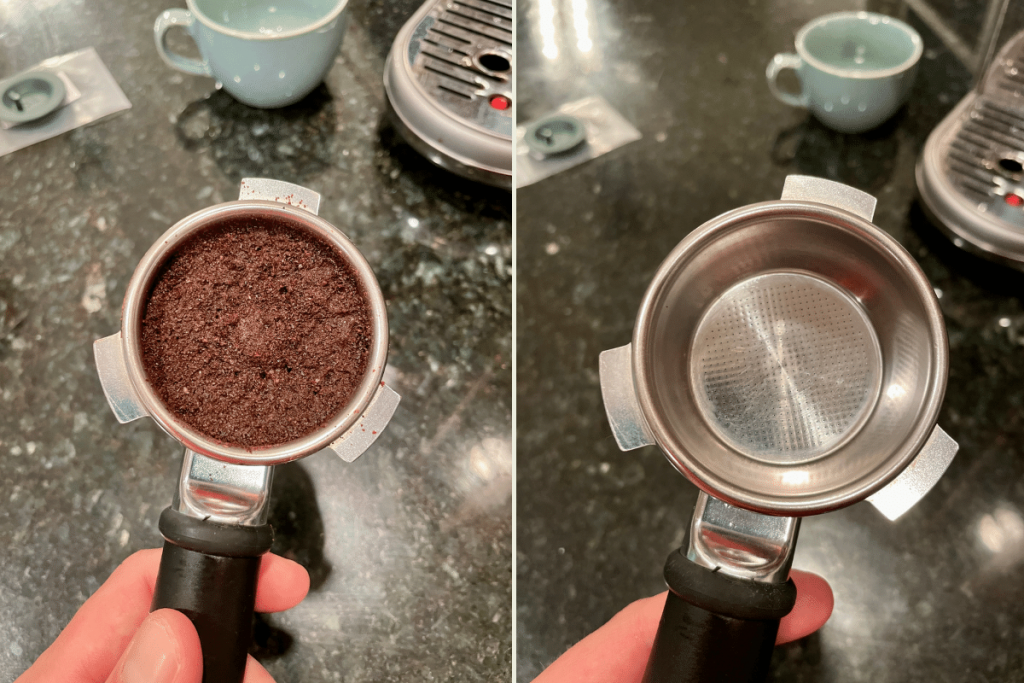
The coffee puck should be knocked out immediately because if you leave it in the machine or the portafilter, the oils and grounds will get stuck to the shower screen and filter basket. I’ve found this to be particularly true when using a pressurized (dual-wall) filter basket.
Use fresh cleaning cloths too. Launder them with detergent at high temperatures and change them once or twice a day if you brew a lot of coffee.
Flush the Group Head
Once you’re done grinding, tamping, and pulling the shot, you should purge the group head straight away for about 3 seconds. This will ensure all the coffee grounds and oils have been flushed out from the head, so your next shot will only be brewed with fresh beans.
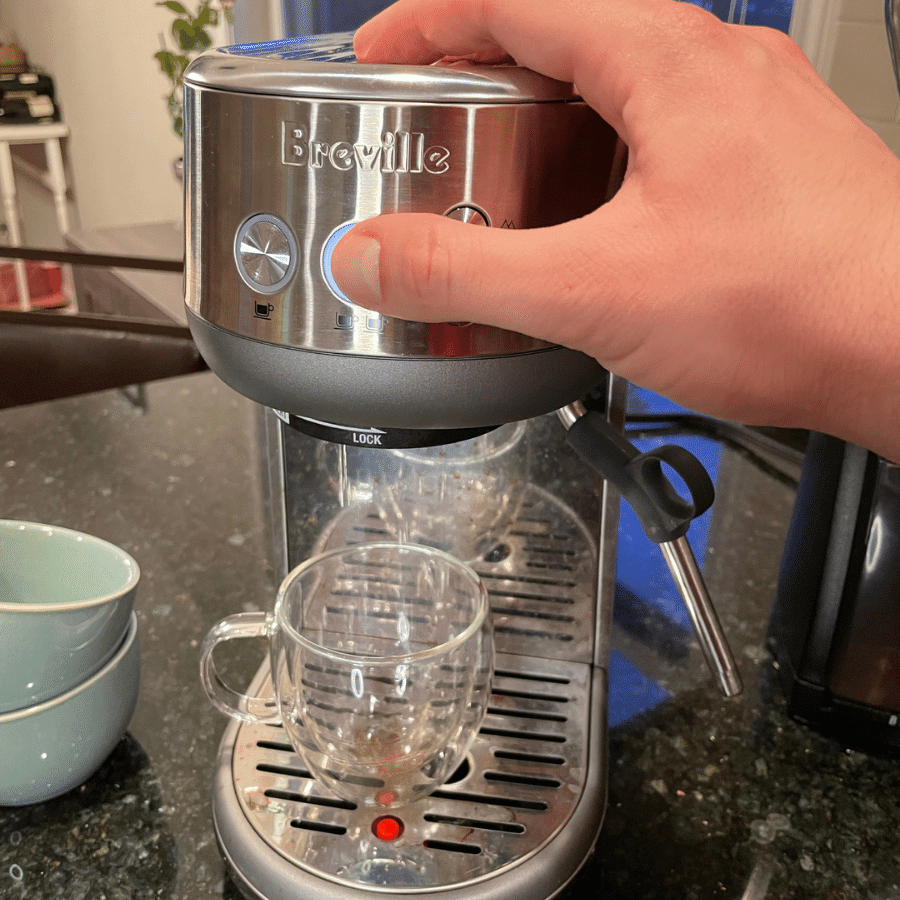
Purge the Steam Wand
Cleaning the steam wand is extremely important because milk buildup can damage the wand. Old heated milk will cause bacteria to build up! Ideally, you should purge the steam wand before and after you steam the milk.
You can turn on the steam wand for a few seconds before steaming. This will ensure you aren’t getting any residual water into your milk. I also found running the steam wand beforehand heats up the wand, so it steams immediately instead of spitting water into your milk.
After you’re done steaming, wipe down the wand with a damp rag and purge again for one to two seconds.
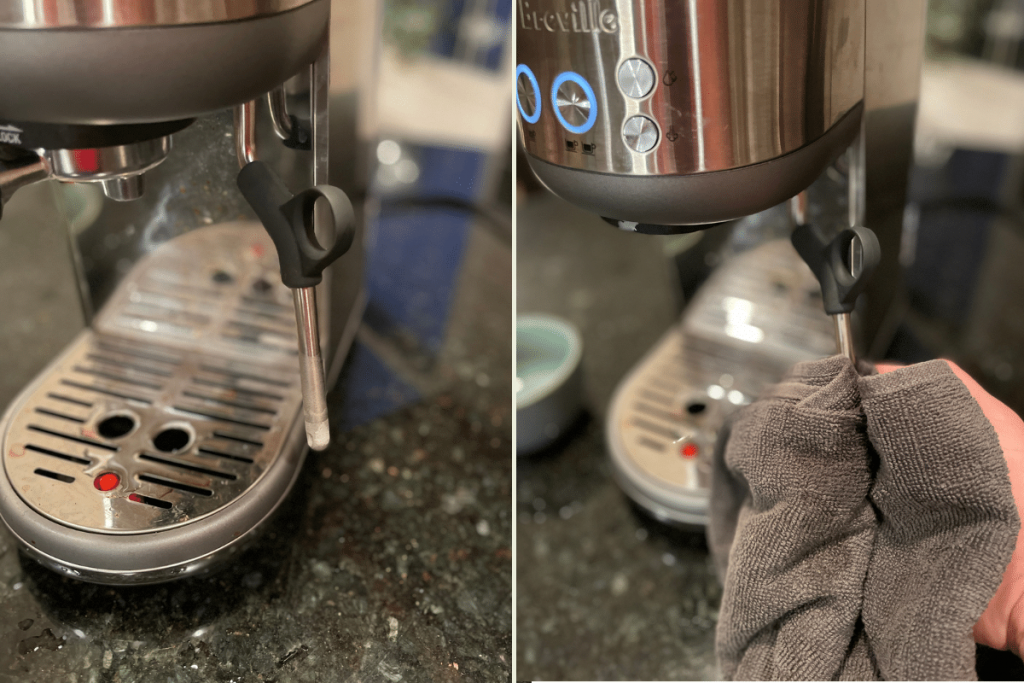
The tip of the steam wand should also be cleaned. Milk most commonly builds up at the tip, which blocks the holes and reduces the steam pressure. Remove the tip of the steam wand and let it sit in a mix of warm water and detergent for at least 20 minutes.
Breville includes a steam wand tip cleaning tool, which has a needle to remove and clean the steam wand. The cleaning tool is located under the water tank.

Parts You Should Clean at the End of the Day
Apart from cleaning after each use, there are some things you should do at the end of the day. Your daily routine should include:
- Clean the group head — Scrub the group head with a machine brush to make sure all grounds are removed.
- Empty the coffee puck container (aka dreg bin)
- Clean the drip tray — Many machines have an indicator that lets you know it’s time to clean the drip tray, but you can also do it once a day to avoid overflowing or spilling. Wash the drip tray in soapy water and dry with a rag.
- Clean the portafilter basket — Rinse the filter basket under fresh water for two to three seconds and wipe it down with a clean cloth.
- Wipe down the outer housing with a soft cloth, and then go over it with a dry cloth. Make sure the cloth is soft. Otherwise, it can scratch your espresso machine.
Note: Read the manual to make sure your machine parts are dishwasher safe. Some machines have removable parts that are dishwasher safe, such as the drip tray and filter basket, while others require you to hand wash all parts.
How to Descale an Espresso Machine
Descaling is the process by which you flush a full tank of water with a specialized cleaning solution through the machine to remove calcium built on the heating element and internal piping. You should descale your espresso machine every three to four months if used daily, and more frequently if you have hard water.
Some espresso machines come with water filters, so there’s no need to descale for a while (the Philips Aqua Clean system can go five years). However, no matter how good your water filter and water quality are, you’re still getting calcium in the heating system, be it a boiler or thermoblock. Over time, calcium builds up, which can damage the machine and make your espresso bitter.
To descale an espresso machine, you need a full tank of water and a cleaning solution, like a commercial cleaning powder.

Most machines will flag when it’s time to descale. I’ll describe the descaling process step-by-step using my Breville Bambino as an example. These specific steps are similar for all espresso machines:
- You’ll know it’s descaling time when the 2-cup button flashes continuously.
- Empty the drip tray and re-insert it into the Bambino.
- Fill up the water tank to the descale line. Add a descaling solution such as cleaning powder to the water reservoir.

- Place a 2-liter container under the group head and the steam wand. Make sure the steam wand is also inside the container, as the machine descales through both the brew head and steam wand.
- Press 2 cups and steam buttons simultaneously for five seconds to start descaling.
- When the descaling solution has been used up, the Bambino will pause the descaling mode.
- Rinse the water tank and refill it to the max line.
- Empty out the wastewater container, and replace it under the brew head.
- Press the 2-cup button to start the rinsing cycle. I used more than one tank to ensure all the cleaning solution was rinsed out. You’ll need a longer rinse with vinegar or citric acid.
- Once the rinsing cycle is done, the machine will be ready to use.
- Remove and empty the wastewater container.
- Rinse the drip tray and the water container and place them back in the machine.
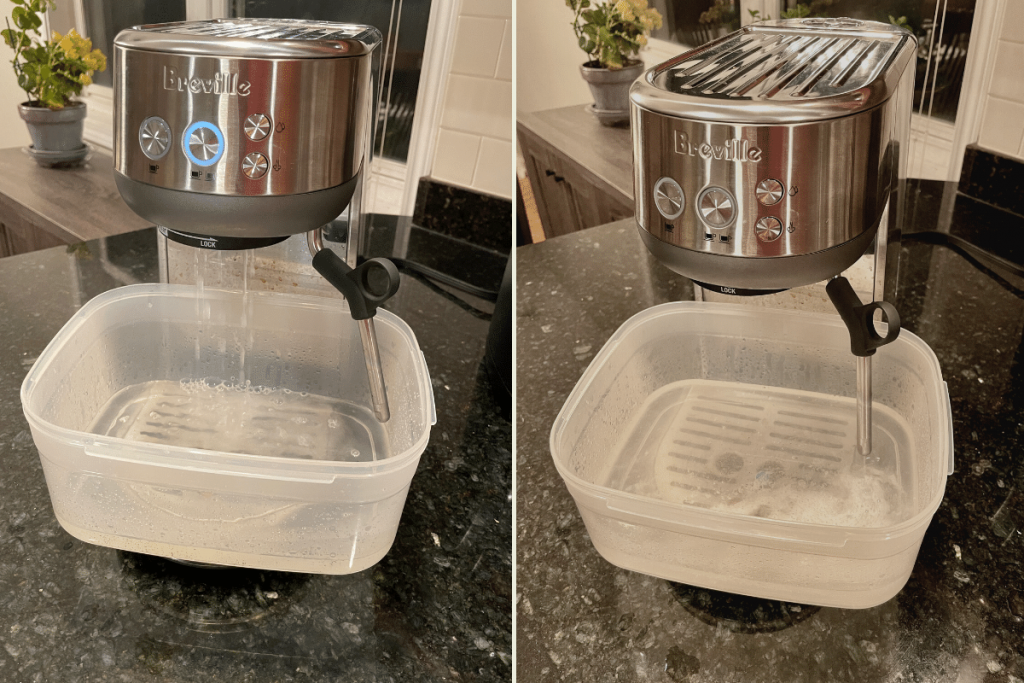
Note: I used the Cino Cleano tablet, which has almost identical ingredients to the Breville cleaning tablets and is half the price. I liked this solution because it uses food-grade ingredients. The only issue is the tablet took 5-10 minutes to dissolve completely.
How to Backflush an Espresso Machine
If you have an espresso machine with a three-way solenoid valve, you should do a backflush once a month at least. A backflush is when you seal the portafilter and turn on the pump. This creates pressure that opens the three-way valve and flushes water back from the group head into the drip tray.
Your machine must have a three-way solenoid valve to do a backflush. For example, the Breville Bambino does not have one, while the Bambino Plus and Breville Barista do. Check your machine’s manual, as the exact process can vary.
You do a backflush because grounds and oils build in the machine valves, interfering with your espresso flavor — it tastes bitter and rancid. When you have small high-pressure streams of water coming out of the shower screen, it’s a sign it’s blocked.
The backflush cleans the shower screen, brew group, and the valve. It cleans a lot of the inside components that you can reach, and it’s simpler than a descale.
Here’s how to backflush step-by-step:
- Remove the portafilter basket and place it in the backflush disc. This is a filter basket with no holes (a blind basket) that prevents water from draining out of the portafilter.
- Add one tablet or a half teaspoon of cleaning solution into the blind filter basket.
- Place the portafilter into the group head and turn on the pump.
- The pump will become quiet at first, which means the pressure is building up. After about 20 seconds, you should hear a whoosh sound as the cleaner is blown up into the brew group and emptied into the drip tray.
- Repeat several times until the foam that comes into the drip tray is clean.
- Remove the handle and rinse out the cleaner under fresh water.
- Place the handle back into the machine and backflush again without the cleaner.
- Switch out the basket with the basket you use to brew.
- Do one more flush to make sure there’s no cleaner residue.
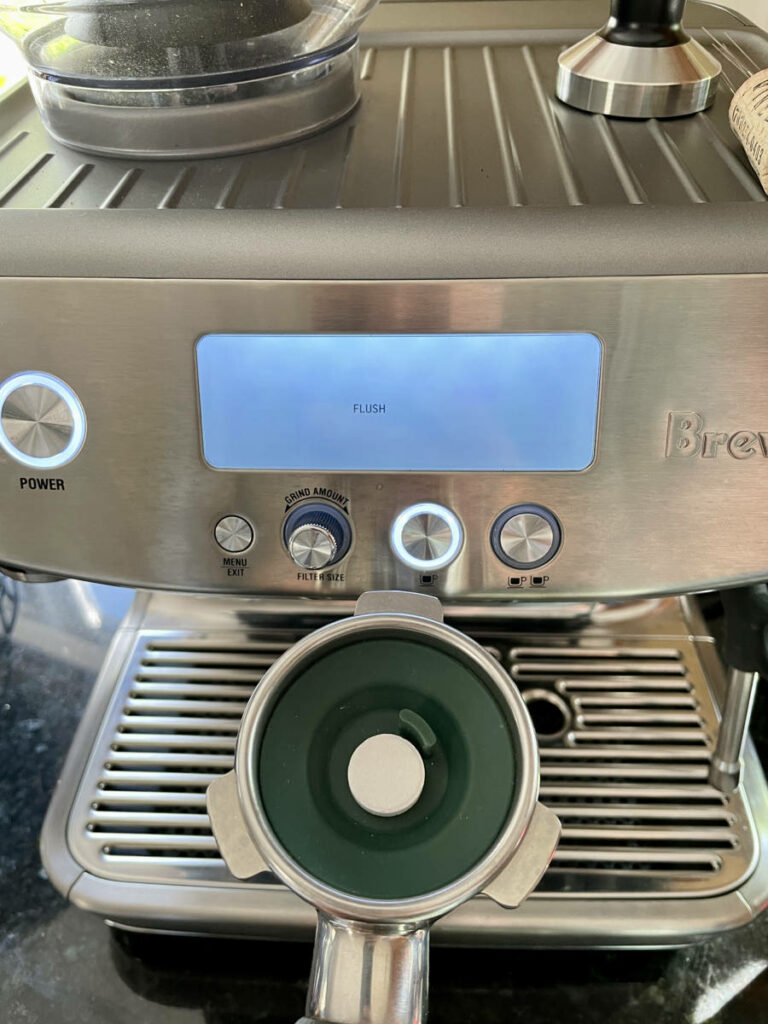
FAQ When Cleaning An Espresso Machine
How often should I clean my espresso machine?
You should clean your espresso machine every day. This includes cleaning the steam wand, purging the brew head, rinsing the portafilters, emptying the puck container and the drip tray. You should also wipe down the machine daily.
You should backflush once a week and descale as soon as the machine indicates it’s necessary.
How often should I descale my espresso machine?
How often you should descale your espresso machine depends on the water hardness and water filter you have. The harder your water, the more frequently you need to descale. A water filter extends the time between descaling your espresso machine.
For example, Breville recommends descaling their machines once a month when using hard water and every three to four months with soft water. On the other hand, the Philips super-automatic machines have an AquaClean filter, which can go 5,000 cups before descale!
What’s the best descaling solution?
The best descaling solution is a commercial descaling solution. I use the Cino Cleano tablets because it has the same food-grade ingredients as the Breville tablets, at half the price.
There’s an ongoing debate between vinegar, citric acid, and commercial solutions. Citric acid is easy and does well, but avoid vinegar because it leaves a strong smell that requires several rinsing cycles to remove. While you can make your own dishwasher detergent, we recommend using a commercial solution.
Final Thoughts
Cleaning the espresso machine is a crucial part of making espresso. Do a quick clean when you’re done brewing and a more thorough clean at the end of the day. Finally, don’t forget to backflush weekly and descale every few months to keep the internals working well.
If you’re looking for a new espresso machine, check out our round-up of the best Breville espresso machines.




